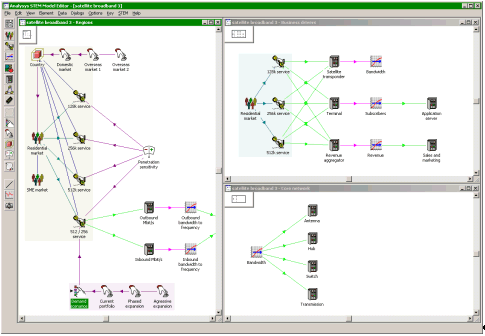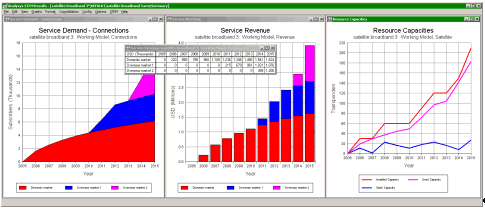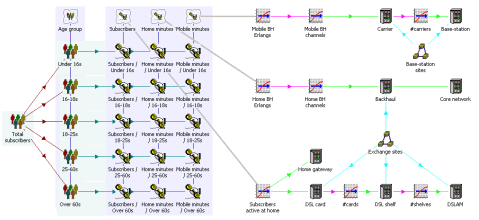 People
typically find out about STEM from colleagues in the context of a particular modelling
application (“have a look at this network transformation model for NGN”), or by
searching the Internet for information on particular technologies (“WiMAX business
model”). What may be less obvious is that STEM is not limited to the first set of
icons you see. STEM’s graphical interface can provide a dynamic and intuitive picture
of the dependencies in any telecoms business, directly facilitating team working.
The common interface and model structure have everyone talking the same language
without needing additional explanation of how a particular spreadsheet works.
People
typically find out about STEM from colleagues in the context of a particular modelling
application (“have a look at this network transformation model for NGN”), or by
searching the Internet for information on particular technologies (“WiMAX business
model”). What may be less obvious is that STEM is not limited to the first set of
icons you see. STEM’s graphical interface can provide a dynamic and intuitive picture
of the dependencies in any telecoms business, directly facilitating team working.
The common interface and model structure have everyone talking the same language
without needing additional explanation of how a particular spreadsheet works.
STEM does mobile; it also does fixed. STEM models TDM; it also models NGN. STEM handles
GSM; it also handles CDMA. STEM supports new services; it also supports convergence. In
fact STEM is deliberately technology neutral, in the sense that dimensioning rules
specific to any given technology will be encapsulated at the model level, rather
than embedded in the software itself.
This has numerous advantages for the user: for a start, there is no software lead
time to be able to model something in STEM, and there is flexibility to model changing
specifications for technologies, which often reach the market ahead of the standardisation
process. Most importantly, you can combine multiple technologies directly in the
same model, either to compare two parallel technologies, or to model a transition
from one to another.
We regularly address new topics and technologies in client workshops and online
demonstrations, and we will showcase this established modelling process in a series
of interactive sessions at the STEM User Group Meeting in September.
Bespoke modelling every time
We advertise a number of reference models on our website
on topics such as FTTX or VoLTE. In fact these are a by-product of the regular interaction
we have with our clients around the world which we save out as documentation to
provide inspiration to our users. For any individual client, there are always specific
factors which make their case special, and unique drivers which can make or break
their particular case. Two recent examples may give a taste of the flexibility on
offer.
Satellite broadband
A satellite operator may offer, or consider offering, different bandwidth rate services
across different international markets, and may wish to optimise current transponder
capacity, or evaluate the business case for launching additional vehicles. A STEM
model was readily tailored to current subscriber numbers, and customised with an
asymmetric bandwidth model to reflect the fact that service packages are typically
2–4 times faster outbound than inbound, due to different efficiency in the technology
going from bandwidth to frequency.

Satellite broadband model structure
We easily added demand scenarios to the model, considering phased expansion into
other territories with respective adverting, sales and administration overheads,
and also measured sensitivities (as tornado charts) to changes in market penetration
for the various services.

Satellite broadband model results
Fixed-mobile convergence
Everyone is considering converged solutions, trying to understand the appeal and
revenue-retention possibilities of a fixed-mobile offering. We explored a demographic
split by revenue and calling patterns and just one tentative network configuration.
We expect to explore many similar scenarios in the coming years as early innovators
stimulate other operators to experiment and compete with their own packages which
may be differentiated by different technology platforms, service bundles or pricing.

Fixed-mobile convergence model structure
Business modelling by storm
We will showcase the development of a complete business-case model in a series of
interactive sessions at the STEM User Group Meeting in September 2007. The focal
point of the event will be a two-track interactive modelling exercise designed to
showcase the apparently magical, whiteboard-to-STEM process which we promote in
our regular training workshops. We establish a clear outline of an intended business
structure, and then translate this into the service/resource structure required
to define the necessary inputs:
- the mix of segments and services considered
- a list of significant cost items
the drivers which dimension the cost items (i.e. the capacity required to provision
the service to end-users).
Over three parallel sessions, we will develop a business model for an online conference
provider offering integrated Web conferencing, VoIP and messaging solutions. We
will explore the target market segments, consider different user profiles and model
the technical drivers for deployment of network resources, as well as the commercial
overheads essential to all such business-case analysis.
|
The novice track will be led by one of our consultants, who will coach delegates
in modelling, checking results at each stage and with some passing mental arithmetic
to verify key orders of magnitude.
|
The expert track will entertain a STEM support engineer and will focus on best practice
and conceptualisation, as well as how to benefit from new features of STEM 7.1 and
the improved interface with Excel.
|
In a final, umbrella session, the two parallel models will be presented and compared,
with each team offering valuable insights and lessons to the other.
Umbrella image: © lakewentworth